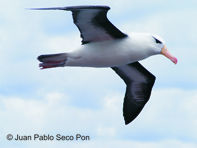Sofía Copello, Juan Pablo Seco Pon and Marco Favero (Instituto de Investigaciones Marinas y Costeras-Consejo Nacional de Investigaciones Científicas y Técnicas (CONICET), Universidad Nacional de Mar del Plata Argentina), writing in the journal Estuarine, Coastal and Shelf Science, have tracked Black-browed Albatrosses Thalassarche melanophris at sea in the south-west Atlantic during the non-breeding season.
The paper’s abstract follows:
“Marine birds like albatrosses have shown a profound deterioration of their conservation status in recent years. The Black-browed albatross (Thalassarche melanophris) is the most abundant threatened albatross species in the Southwest Atlantic continental shelf. Declines in their breeding populations have been largely attributed to the impact of incidental mortality in fisheries. Data on at-sea distribution for the species during breeding is abundant, but movements of individuals during winter are poorly known. Here, we investigate the at-sea distribution of Black-browed albatrosses during the non-breeding seasons 2011 and 2012. Eleven adult individuals were captured at-sea and equipped with satellite tags. Distribution of tracked Black-browed albatrosses was mostly restricted to waters within the continental shelf of Argentina, Uruguay and southern Brazil; from 29° to 51°S. Two large marine areas, comprising the ca. 90% of the core area (50% utilization distribution) were identified; one from the mouth of Rio de la Plata toward the E and SE reaching the shelfbreak, and another in El Rincón estuary and waters to the South. Tracked birds were distributed over nine oceanographic regimes in the SW Atlantic continental shelf, spending between 5 and 34% of their time at sea in marine fronts of high productivity such as Río de la Plata, Los Patos lagoon estuary front, the shelfbreak and the mixed front. The identified core areas could be considered as proxy indicators of priority areas at the time of implementing conservation measures for the species. The analysis of overlapping with fisheries on the Argentinean Continental Shelf will provide further insights about critical areas where those measures should be more stringent.”

Reference:
Copello, S., Seco Pon, J.P. & Favero, M. 2013. Use of marine space by Black-browed albatrosses during the non-breeding season in the Southwest Atlantic Ocean. Estuarine, Coastal and Shelf Science doi.org/10.1016/j.ecss.2013.02.016.
With thanks to Juan Pablo Seco Pon for infomation.
John Cooper, ACAP Information Officer, 06 April 2013

 English
English  Français
Français  Español
Español